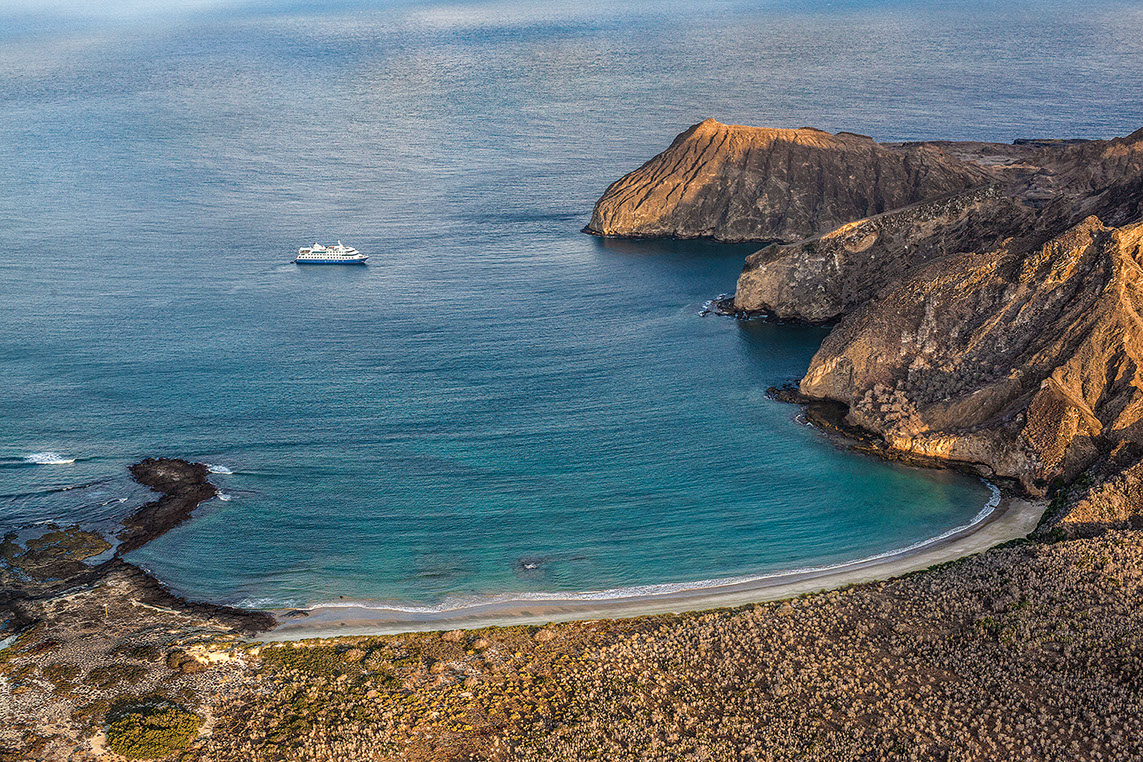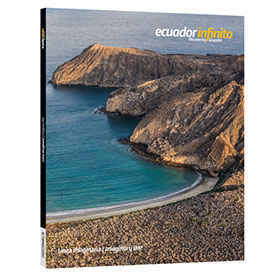
Portada/ Cover:
Galápagos / Galápagos
Juan Sebastián Rodríguez
El fotógrafo en su afán por ver a las Islas Galápagos desde un nuevo enfoque decide embarcarse en un helicóptero y reconocerlas desde el aire, una manera completamente nueva de ver la belleza de estas islas.
The photographer in his eagerness to see the Galapagos Islands from a new approach decides to embark on a helicopter and recognize them from the air, a whole new way to see the beauty of these islands.
38
Ecuador Infinito es una revista dedicada a mostrar el Ecuador a través de magníficos textos y fotografías de los mejores profesionales. Se realiza gracias al auspicio de importantes empresas e instituciones que creen en el país.
Ecuador Infinito is a magazine dedicated to showcasing the magnificent Ecuador through texts and pictures of the best professionals. Thanks to the sponsorship of major companies and institutions who believe the country is done.
Ecuador Infinito 38:
Línea imaginaria / Imaginary line
Contenido
Preludio / Salinas y su Mar
Prelude / Salinas and its Sea
Sebastián Padrón
fotografía/photography
Ciudades Infinitas / Zaruma en la noche
Infinite Cities / Night in Zaruma
Rinaldo Wurglitsch
fotografía/photography
Carta del director / Línea Imaginaria
Editor’s letter / Imaginary Line
Rómulo Moya Peralta
texto/text
Amazonía / Insectos Fantásticos
Amazon / Fantastic Insects
Lucas Bustamante
texto y fotografía/text and photography
Amazonía / Pedro Vicente Maldonado y el país de la canela
Amazon / Pedro Vicente Maldonado and the country of cinnamon
Evelia Peralta
texto/text
Amazonía / Niebla nocturna
Amazon / Night Fog
Carlos “Sakki” Durán
fotografía/photography
Producto / La cocina contemporánea y el chicharrón de chontacuro
Product / Contemporary kitchen and cracklings chontacuro
Liz Briceño texto/text
Marco Mancero Chef
Marko Bizarro fotografía/photography
Sierra / Cabalgar a través de la luz de las montañas
Sierra / Riding through the light of the mountains
María Emilia Moncayo
fotografía/photography
Sierra / Cartografía mínima para un país telúrico
Sierra / Minimal Cartography for a Telluric Country
Valeria Guzmán Pérez
texto/text
Biodiversidad/ Flor de páramo
Biodiversity / Páramo flower
Rómulo Moya Peralta
fotografía/photography
Sierra/ Aquelarre de brujas norandinas
Sierra/ Coven witches norandinas
Juan Carlos Morales
texto/text
Rostros / El danzante del Inti Raymi
Faces / The dancer Inti Raymi
Juan Carlos Morales
texto/text
Marko Bizarro
fotografía/photography
Sierra/ Iglesia y convento de Guápulo
Sierra / Church and convent of Guápulo
Rómulo Moya Peralta
Texto y fotografía/Text and photography
Sierra/ El fuego de una corazonada
Sierra / The fire of a hunch
Edu Naranjo
Texto y fotografía/Text and photography
Costa/ Ranas de cristal
Coast/ Glass frogs
Alejandro Arteaga/Lucas Bustamante/Frank Pichardo
Texto y fotografía
Costa/ El diablo no pacta con mujeres
Coast / The devil does not pact with women
Ernesto Intriago
Texto/Text
Flora y fauna / Cascada Tortuga y Velo de novia
Flora and fauna / Waterfall Turtle and Bridal Veil
Elías Suárez
fotografía/photography
Costa / Un día en la memoria
Coats / One day in memory
Norka Guevara
texto/text
Costa/ Serás
Coast/ Serás
Marialuz Albuja
texto/text
Juan Carlos Morales
fotografía/photography
Galápagos / La naturaleza es única, pura, evolutiva y frágil
Galápagos / Nature is unique, pure, evolutionary and fragile
Juan Sebastián Rodríguez
texto y fotografía/text and photography
Galápagos / Theatrum Orbis Terrarum, unas islas, un lugar en el mundo
Galápagos / Theatrum Orbis Terrarum, some islands, a place in the world
Rómulo Moya Peralta
texto/ text
Descubrimiento / El primer atlas moderno
Discovery / The first modern atlas
por/by Abraham Ortelius
Diversidad / Estrella de Mar
Diversity / Starfish
Liz Briceño
texto/text
Fernando Cornejo
fotografía/photography
Paisajes Infinitos / Crepúsculo quiteño
Infinite Landscapes / Quiteño twilight
Cristóbal Ocaña
fotografía/photography
Línea imaginaria
La poética de la geografía nos lleva a encontrar diversos sentidos al espacio donde se desarrolla nuestra vida, al paisaje, al campo, a la ciudad, a la Sierra, a la Costa, al mar, a la floresta, a la memoria o a la cultura.
Bien podemos referirnos a un espacio real o a un espacio imaginario, a un lugar del cual se tiene una localización espacial, temporal y precisa; o a un espacio imaginado que nace de nuestra percepción, mitología, historia o construcción poética.
El ámbito geográfico es la piel y, a la vez, la profundidad de nuestro planeta, superficie terrestre, espacio habitable, accesible, comprensible y concreto. Esta piel está viva y se conecta con su centro, se mueve, estalla, se manifiesta, se modifica continuamente. Cada porción del espacio natural, tiene marcado en sí, el presente y el pasado. Pero también es un espacio percibido y sentido por el habitante o por el científico que es capaz de entender sistemas y generar pensamientos a partir de su estudio.
Caminar entre dos hemisferios es privilegio de pocos, como caminar por la cornisa terrestre. En el siglo XVIII la verdadera forma de la Tierra era motivo de hipótesis, luego gracias a las mediciones hechas en este territorio supimos que Newton tenía razón, que la Tierra, por el movimiento de rotación, es achatada en los polos.
Nuestra línea imaginaria significa mucho, porque, en el ecuador del planeta, el Sol y las estrellas tardan el mismo tiempo en estar por encima del horizonte que por debajo.
La geografía nos llevó a llamarnos como se llama una línea imaginaria, pero no cualquier línea, la palabra “ecuador” significa “línea de la igualdad”. Desde antes, pero también desde entonces construimos una identidad, tratando de no olvidar que por esta tierra había pasado una historia gigante que quedó marcada a fuego por los antepasados. Los Geodésicos Franceses descubrieron la mitad del mundo para el resto del planeta, aquí ya estaba descubierta.
Así la geografía nos ubica como un referente, porque las líneas imaginarias, son líneas que nos ayudan a ubicarnos en la Tierra y, aunque sólo están presentes en los mapas, nosotros podemos vivir cotidianamente con la nuestra, porque nos apropiamos de su nombre y así nos hicimos universales.
Por eso decimos que Ecuador es un país particularmente marcado por su condición geográfica, por sus orígenes históricos y sus procesos evolutivos, quizás más que muchos otros en el contexto planetario.
En lo microscópico y en lo inmenso, es un país de mil historias que, aunque parecen fantásticas, son reales. Desde animales que los vemos en películas como si fuesen ciencia ficción, hasta pueblos que quedan arriba de las nubes; desde plantas que soñamos que nos curan hasta descubrimientos imposibles para su tiempo... así es este territorio.
País de soles que se esconden bajo las sombras cuando nadie los espera, de tradiciones que se mezclan en el tiempo haciendo realidad las más remotas fantasías. En el Ecuador los mitos y las leyendas cobran vida, levantan catedrales y parten al mundo en dos.
Línea imaginaria que nos surca, nos ubica, nos identifica, que da lugar a que lo fantástico sea real, que la leyenda sea historia verídica, que el descubrimiento asombre porque parece imposible.
Ecuador, país de primavera, de semillas y de plantas, de vínculos ancestrales, de soles de maíz, de esperanzas, país de mil pájaros cantando, de nubes que se atreven a las cimas, de colibríes bailando alocados, de mares con raíces hasta el cielo, territorio azul, con poniente dorado, por tus venas pasa el magma de los tiempos.
Imaginary line
The poetics of geography brings us to find many meanings in the space where our lives unfold; in the landscape, the countryside, the city, the mountain, the coast, the sea, the forest, in memory or culture. We can refer to a real place or one of the imagination, one that has a precise location bound by space and time; or a an imaginary space born of our perception, mythology, history or poetic construct.
The geographic space is simultaneously the skin and the depth of our planet, a superficial terrain, a space that is inhabitable, accessible, comprehensible and concrete. It is a living skin connected to its core, moving, exploding, continuously manifesting and modifying it self. Every portion of natural space has both the present and the past marked within it. It is also a space that is perceived and sensed by the inhabitant or the scientist who is capable of understanding systems and generating thoughts through research.
Few have the privilege to walk between two hemispheres, like walking along the edge of the earth. In the eighteenth century, the true shape of the Earth was a matter of hypothesis. Then, thanks to the measurements made in this area we knew that Newton was right, that the Earth, by effect of its rotational movement, is flattened at its poles.
Our imaginary line is of great significance, because here at the planet’s equator the sun and the stars are above the horizon for the same amount of time as they are below it.
Geography led us to name ourselves after the word for an imaginary line, but not just any line. The word “equator” means “line of equality.” Before, as well as since then we have constructed an identity, trying not to forget that this land has endured a gigantic history that was blazed by our ancestors. The French Geodesic discovered for the rest of the planet what was already known here: the middle of the world.
Thus, our geography serves as a benchmark: these imaginary lines are the lines that help us to orient ourselves on Earth. Although they are only present on maps, we can live daily with ours, because we have appropriated it as our namesake and in doing so we have become universal.
That is why we say that Ecuador is a country that is particularly marked by its geographical condition, its historical origins and evolutionary processes, perhaps more so than many others in the global context.
In the microscopic and in the immense, it is a country of a thousand stories, that, fantastical though they may seem, are real. From animals that look like they came out of a science fiction movie, to cities built above the clouds, from plants that we dream will heal us to discoveries impossible for their time...such is our land.
A country of suns which hide beneath the shadows where no one expects them, of traditions blended over time turning the wildest fantasies into reality. In Ecuador, myth and legend come to life, erect cathedrals and part the world in two.
The imaginary line that ploughs through us, gives us our place, our identity, turning fantasy into reality and legend into historical fact, an astonishing discovery seemingly impossible.
Ecuador, a country of Spring, of seeds and plants, of ancestral ties, of maize suns, of hopes. A country of a thousand songbirds, of clouds that dare to climb the topmost slopes, of crazily dancing hummingbirds, of oceans with roots up to heavens, blue territory, golden in the west, through whose veins flow the magma of time.
Rómulo Moya Peralta, arq.
